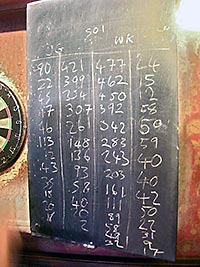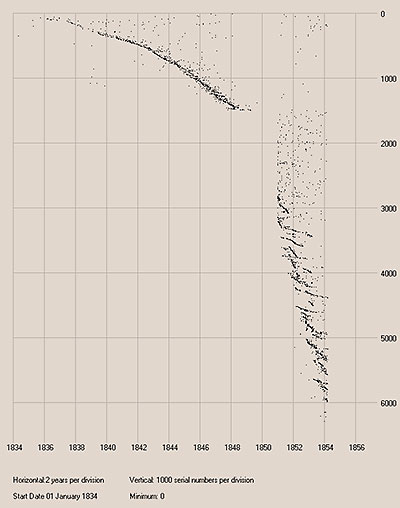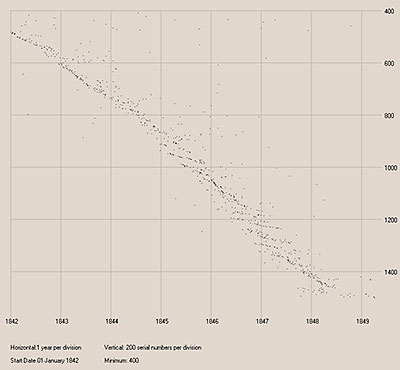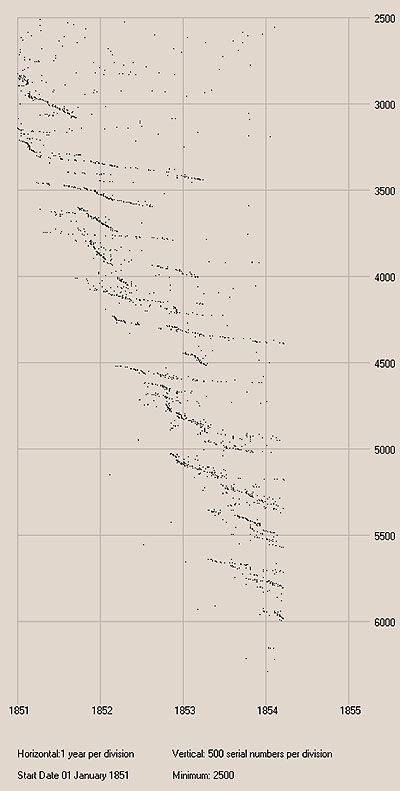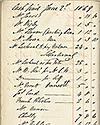Most users of the Wheatstone ledgers visit the Horniman
website to try to
determine the manufacturing date or selling date of a specific Wheatstone concertina
from its serial number. For many
instruments this can involve extensive searching, as some of the early ledgers show an apparently
random jumble of serial numbers listed by the date that instruments were sold,
exchanged or hired. Even if repeating serial numbers caused by exchange or hire
are ignored, the ledgers still show a jumble of numbers. This note contains the
results of some basic investigation to show what is happening, using the first
four sales ledgers, C104a, C1046, C1047, and C1048. I show that a major source of the
jumbled sequence is the practise of selling (and we presume also making) multiple ranges
of serial numbers at the same time, a feature which the ledgers show to have changed
character and become much more pronounced after 1850. (This is a preliminary version, and
will be replaced by a fuller report and further data files as work progresses.)
Examination of the ledger data, confirmed by other readers, shows that the
earliest date written in the ledgers is "22 Oct 26" (i.e. 1826) for serial number 381
(Ledger C104a, page 20).
Apart from being illogical (a date prior to the first Wheatstone patent in 1829),
it can be shown that this is an error, since
ledger C1046 contains an almost identical entry on
page 51, but for 21 Oct
1846. Further examples of differences between C1046 and C104a can be found,
and there is no reason to suspect that similar errors may not have
equally occurred in later ledgers. The data from this investigation makes
no attempt to correct any of these errors. Errors will also almost certainly
have occured in transcribing the investigation data from the photographs of the ledgers, and
reports of any of these errors will be gratefully received.
The ledgers investigated so far cover the period May 1834 (although this may
also be an original ledger error) to March 1854. However, some parts of this
range are not covered, and only the dates June 1839 to April 1848 and
January
1851 to March 1854 are covered in depth. Ledger C104a covers the first
1500 serial numbers, and provides some of the missing coverage. According to
ledger C104a, one instrument is sold in 1834, three in 1835, and fourteen in
1836. No instruments are listed for the first half of 1837, suggesting that
those records may have already been lost when C104a was compiled. Sixteen
instruments are listed for the second half of 1837, so the Wheatstone
concertina output was beginning to increase considerably.
Searching for serial numbers between 1 and 1500 appears to be simple, as
ledger C104a is ordered by serial number. However, investigation shows that
dates given in C104a tend to be for a 'final sale' (by 9th September 1849, the
latest date in C104a), and cross-checking with entries from ledger C1046 shows
that some instruments were first sold years before the date entered in C104a.
For example, serial 759 first appears in C1046 in July 1844, and makes two more
appearances (December 1844 and July 1846) before its entry on 13th Oct 1846, the
date given in C104a. Many instruments have earlier entries than their C104a dates,
with their manufacture much nearer that of other instruments with similar value
serial numbers.
The plot below shows the 'earliest dates' for serial numbers that appear
in the ledgers used so far.
In this graph, serial numbers are scatter-plotted from numbers near 0 at the top, down to
serial numbers above 6000 at the bottom; each division is 1000 serial numbers.
From left to right, each division is two years, running from 1834 to 1856.
We see immediately a major difference roughly around 1850 (which is also, unfortunately, the
break in the data caused by a missing ledger); the occurrence of serial numbers for 1834–1850
is very different from the occurrence of serial numbers after 1850. In the earlier period, we
see basically a single main descending diagonal line, showing a single sequence in which serial numbers get larger as
time gets later. But in the later period, we see multiple descending diagonal lines, showing more than one
sequence of serial numbers being produced at the same time.
(In both periods, there is a scatter of numbers around the major features.)
It has been suggested that the muddle of serial numbers in the ledgers
has been partially caused by multiple production sources for
instruments, with allocations of groups of serial numbers to particular
sources causing years of difference between instruments of similar
serials.1 Although
this investigation cannot demonstrate multiple
sources, it can confirm that multiple 'range-lines' of serial numbers
were occuring in the sales recorded by the ledgers. If we look more
closely, we can actually discern that the sub-pattern of multiple
overlapping production ranges begins before 1850, and seems to be evident
as early as 1845 (see below). The results also show that in the early years
this effect is not as pronounced as later.
In this graph, serial numbers are scatter-plotted from numbers near 400 at the top, down to
serial numbers above 1400 at the bottom; each division is 200 serial numbers.
From left to right, each division is a single year, running from 1842 to 1849.
At this scale, we can discern an internal structure of overlapping ranges,
usually up to three ranges being produced simultaneously over periods of up to a year each.
By the end of 1851, these multiple range-lines dominate the Wheatstone output
and at least seven range-lines seem to be active. Within a few years the spread
of range-lines becomes even wider—the first instrument in the 7000s appears at
the end of C1048 (March 1854) even though few instruments with numbers in the
6000s have been sold. There is also a significant gap below 5640 with
instruments around 5560/5570 only just starting to appear in sales. The lowest
range-line still operating in March 1854 is producing instruments at
approximately serial number 4390, so there is a gap of almost 2700 between
highest and lowest range-lines in active sales.
In this graph, serial numbers are scatter-plotted from numbers near 2500
at the top, down to serial numbers above 6000 at the bottom; each
division is 500 serial numbers. From left to right, each division is a
single year, running from 1851 to 1855. At this scale, we can see more
overlapping ranges, up to seven or more being sold simultaneously, over
periods of typically multiple years. The random mass of points in the range
2500 to 3000 indicate an area where we do not have earlier data
(roughly 1848 to 1851), and most of these serial numbers will have
earlier origins.
In summary, the plots above have shown that a major contribution to the
muddling of serial numbers in the early ledgers is that multiple
range-lines of serial numbers are in use at any one date, and that this
is further complicated by instrument exchanges and hires. The multiple
range-lines are a feature of sales before 1850, but only a few ranges
are sold at a time, and for briefer periods, so that they blend into a
fairly-simple sequence. After 1850, the multiple range-lines dominate
the structure of sales, with many simultaneous ranges extended over
longer periods. The true causes of these range-lines cannot be defined
by this investigation, and it is hoped that future research will
provide some answers.
The investigations made here also lead to a further observation. The C104a
entry for serial 334 gives serial, date and buyer. When C1046 is checked for
the same date, an entry shows the same buyer name, without a serial, but adds
the number of buttons of the instrument. The presence of single source data
like this indicates that C104a and C1046 have been compiled independently of one
another, using another source or sources.
Demonstration of the presence of these range-lines opens up at least two
further aspects of ledger research. Ledger entries for sales without serial
numbers are no longer subject to a totally random possible serial number, and
more probable numbers may be suggested for these entries. In the future, it
may also be possible to correlate sales prices with these range-lines and
demonstrate if they represent distinct types of instrument.
Data from the Wheatstone Ledgers
Below are links to files containing the data used to generate the scatter plots discussed
in this article. The same data is available in two different formats: in "comma-separated-value" (CSV) format and in XML format.
So far data is available for four ledgers (which were used to make the graphs above). The data is further available
on web pages (where each record is linked to its photograph in the online ledgers) to be consulted or printed.
All file data should be checked against the original ledgers, as transcription errors may have occurred.
Please report
any errors.
Data from the Wheatstone Ledgers in CSV (Excel, etc.) Format
The data is arranged as a single file for each ledger.
Each file is in CSV (comma separated value)
format, the standard used by spreadsheets for 25 years.
Each file can be eyeballed by opening it in a simple text editor
(e.g., Notepad) using a line terminator of the two ASCII characters
"carriage-return" and "line-feed" (<CR><LF>).
Each file contains one record per line. Each record
contains four comma-separated fields, for example:
C1049,05,18540508,0213*
Each file contains a dummy first record containing the field
names
Ledger,Page,Date,Serial
Second and subsequent records contain:
- Ledger Number - as used by the Horniman Museum website,
5 alpha-numeric characters.
- Page Number - two digits<./li>
- Date - eight digits in yyyymmdd format.
- Serial - the serial number and any note, variable length.
A number of codes following the serial number are used to signify additional information.
Most of them indicate that the ledger shows that the instrument was made by another maker
and/or for another dealer,
and so the serial number is probably not a Wheatstone number. (Most of these makers are
profiled in "Minor Historic Concertina
Makers and Dealers", by Wes Williams.)
Other codes indicate sales
to buyers with serial numbers that may be non-Wheatstone, an unusual model of instrument
(such as "double" duets which had a separate serial number sequence),
or improbability of the serial number as read and/or uncertainty in reading the number.
Codes used are:
- 'A': Made for A. B. Sedgewick
- 'B': Bass instrument
- 'C': Made by Rock and Edward Chidley
- 'D': Double system duet instrument
- 'F': Notation of "Frames" plus irregular price
- 'G': Made by George Case
- 'H': Anglo-German instrument
- 'J': Made by John Simpson
- 'L': Made by Louis Lachenal
- 'M': Made for J. B. Cramer & Co.
- 'N': Made by Nickolds
- 'P': Made for Keith, Prowse & Co.
- 'R': Made by Rudall
- 'S': Made by Joseph Scates
- 'T': Made by Turner
- 'X': Made by Rock Chidley
- '?': Sold to Boosey/Case/Scates with unusual serial
- '*': Sold to Boosey/Case/Scates with unusual serial
- '+': insertion written vertically near serial 248
- '!': Uncertain
For ledger C104a, a record indicates that a serial number entry
is not completely blank. For all other ledgers, only entries
containing both date and serial number are recorded.
This data may be used with any program (such as Excel) to produce scatter plots or other kinds of graphs.
A simplified version of the specialized program used to produce the
scatter plots used in this article, with a corresponding serial
number search program, is available from the author.
Data from the Wheatstone Ledgers in XML Format
(XML is supposed to be self-documenting; take a look and see!)
Serial Number Indexes to the Wheatstone Ledgers
(Web pages with sorted indexes to serial numbers in the Ledgers, linked to photographs—just find the serial
number in the list and click.)
Available indexes to the Wheatstone Ledgers listed in a directory: Serial
Number and Date Indexes to the Wheatstone Ledgers.
Author
Wes Williams
(
)
was fascinated by a 46-key Maccann Duet concertina and its history while studying
Electrical and Electronic Engineering at Kingston University, Surrey in the early 1970s.
After moving to Somersetshire in 1974, he slowly accumulated information on concertina makers,
and in 2001 wrote a brief inaccurate summary for Concertina.net, which led to
contact with fellow researchers. While searching for information from the
International Concertina Association (founded 1952), he was volunteered
for Archivist, and is now attempting to relocate, preserve, and make available
the information gathered by the Association during its 50 year long history.
